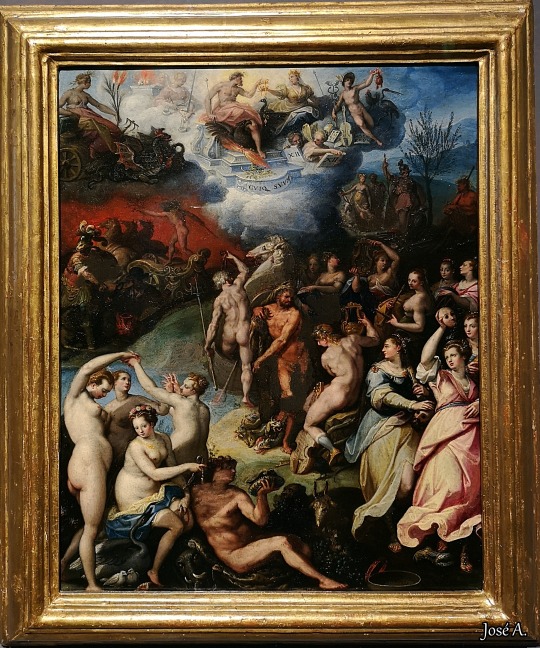#de natura deorum
Explore tagged Tumblr posts
Quote
No one can be happy without virtue.
Cicero, De Natura Deorum
109 notes
·
View notes
Text

27 notes
·
View notes
Text

self aware Cicero saturday
2 notes
·
View notes
Text
Was reading De Natura Deorum by Cicero and...my head....
"The first Venus, who has a temple at Elis, was the daughter of Cœlus and Dies. The second arose out of the froth of the sea, and became, by Mercury, the mother of the second Cupid. The third, the daughter of Jupiter and Dione, was married to Vulcan, but is said to have had Anteros by Mars. The fourth was a Syrian, born of Tyro, who is called Astarte, and is said to have been married to Adonis."
So um...??
Seems like some ancients saw that in some myths Venus came from the foam of the sea and in other myths was the child of Jupiter and Dione, and they just went "mm yes that simply means there are like 5 different Venuses who all have the same name and the same domain, but these different myths correspond to only one of those" ... like that's not my explanation for why there are different genealogies in different myths at all...
A difference in genealogy makes a wholly separate deity who still has the same name and domain, this is like super hard polytheism lmao
Also interpretatio romana got in the way here lol, funny how instead of saying "Venus is Astarte just under a different name for the Syrians" they go like "Astarte is yet another Venus who is her own separate individual to our Venus", funny how they went full circle back to hard polytheism lmao
#my head hurts trying to piece out the full genealogy of this thing lol#religio romana#roman pagan#roman paganism#roman gods#rompol#roman pantheon#roman polytheism#roman polytheist#ancient roman religion#interpretatio romana#cicero#roman philosophy#roman theology#venus#astarte#de natura deorum#hard polytheism#soft polytheism
0 notes
Text

#wait where's that bit from the de natura deorum describing the epicurean guy. i have to find it#thoughts
2 notes
·
View notes
Text
Today is the rest before the storm of reading a book a day for a week in my second language.
Have, literally, no idea what I'm going to read.
Meh, I guess old faithful Cicero for tomorrow and then we'll see afterwards?
caesar ? idk
Good luck to @sophisotes who (maybe? unsure) is possibly also participating!
#i totally didn't steal this sentence (sorta) off @sophisotes)#absolutely going to burn out halfway through De Natura Deorum#Wooo!!#Latin#reading competition#reading
4 notes
·
View notes
Text

Lady Selene,
Goddess of
The Lunar Month
The Greek months start with the new moon and were then divided into three ten day periods. The first ten days were presided over by the waxing moon, the next ten were the near full and full moon, and the last ten was the waning moon. Festivals including the lucky and unlucky days of the month were measured in the cycles of the moon.
Evelyn-White. "Long-winged Meme... at eventime in the mid-month: then her great orbit is full and then her beams shine brightest as she increases. So she is sure token and a sign to mortal men" (Homeric Hymn, 32 to Selene: C7th- 4th B.C.)
Childbirth
Pregnancies were commonly measured in lunar months, so Lady Selene had a natural association with childbirth.
Timotheus. "Through the blue-black vault of the starts and of Selana who gives swift childbirth." (Campbell Vol. Greek Lyric V, Frag 803: C5th B.C.)
Dew
The moon was believed to nourish plants and animals with her dew. Lady Selene was associated with Ariadne, wife of Dionysus as the goddess of nourishing.
Cicero. "Luna the Moon's course also has a sort of winter and summer solstice; and she emits many streams of influence, which supply animal creatures with nourishment and stimulate their growth and which cause plants to flourish and attain maturity." (De Natura Deorum, 2.14: 45 B.C.)
and the Moon
Tryphiodorus. "When Mene (the Moon) [Selene], full with grey fire, gilds with her face the gleaming heaven: not when, sharpening her pointed horns, she first shines, rising in the shadowless dusk of the month, but when, orbing the round radiance of her eye, she draws to herself the reflected rays of the sun." (The Taking of Ilias, 514:C6th A.D.)
Who is Selene?
The titan goddess of the moon. She was depicted as a woman riding a sidesaddle on a horse. Her lunar crescent was set upon her head as a crown. She was said to sometimes drive a team of oxen and her lunar crescent was likened to a pair of bull's horns.
Symbolisms of Selene
Crystal: Moonstone
Colors: Silver, Grey-white, and white
Day of the week: Monday
Scents/Flowers: Myrtle, willow, white poppy, white rose, and wall flower.
Animals: Bulls and horses
Offerings
Silver jewelry, curved crescent knives, silver/white coins, silver/white candles, cups of (salt) water, seed pods, mirrors, white flowers, any sea/tide related offerings, mooncakes, writing hymns.
Ways to worship
Wearing silver jewelry
Wearing moon colored clothing
New Moon: banishing and undoing things.
Waxing Moon: offerings that relate to things you want more of. Great time for offerings
Full Moon: Harvest what you've been working on
Waning Moon: leave offerings that you want less of.
Taking items from your altar outside or on a windowsill during a full moon.
Cleansing the altar and offering items with water charged with moonlight during a new moon.
Going for a walk under the moonlight(with safety precautions)
Talking to the moon
Learning astrology
Stargazing
Meditation at night.
#selene deity#hellenic worship#paganism#pagan#greek gods#divine#altar#hellenic gods#selene#pagan witch#witchblr#paganblr#witch#goddess worship#deity worship#goddess#offering#hymn#homeric hymns#moon#deity offerings
123 notes
·
View notes
Text
A god to consider: Iris 🌈🪽

Before the messenger Hermes, there was a different servant god who carried the words of Olympus to and thro, and her name is Iris. Daughter of the titan Thaumas, and the oceanid Electra, the colorful goddess, and personification of the rainbow, personal assistant to Zeus, Iris is a sort footed, golden winged goddess who carries out the tasks and messages of her master. In the Iliad, when Zeus sends the notice of death to Priam of his son, Iris is the one sent to inform him. Later, she would become more aligned with her loyalty to hera, becoming her envoy, and being the one who commanded lyssa to inflict Heracles with the frenzy that caused him to murder his sons at heras request. Despite this side of her, Iris is also the patron restorer of peace in nature, and the divine deliverer of heavenly messages and gifts. In modern times, some also associate her with creativity and inspiration, especially in artistry, the colors of which she is the embodiment of. Next time you see a rainbow, say a thank you to Iris, and open an ear to see if you might hear a message she carries for you…
If you wish to learn more about Iris, consider referring to the sources and stories I’ve listed below! If you wish to learn more about the gods of Hellen, and the stories of Greek Mythos, consider giving my blog a follow. I post about Hellenism and more daily. Blessed be your day.💙🏛️💙
- Sources:
Wikipedia.org
Theoi.com
Greekmythology.com
- Relevant stories:
The Iliad (Homer)
Silvae V (Statius)
Fall of Troy (Quintus Smyrnaeus)
Metamorphesis (Ovid)
De Natura Deorum (Cicero)
#male witch#green witch#paganism#hellenism#witchcraft#druidism#hellenic worship#baby witch#pagan witch#hellenic deities#iris deity#iris goddess#iris#iris devotion#lady iris#hellenic paganism#hellenist#hellenic pagan#hellenic gods#hellenic witch#hellenic community#hellenic polytheism#hellenic polythiest#hellenic devotion#greek deities#greek mythology#greek stories#the iliad#greek gods
42 notes
·
View notes
Note
In what source is Eleutheria, the goddess of liberty, a daughter of Hera?
Pseudo-Hyginus (Fabulae Preface) says that Jupiter had Libertas by Juno, but I'm not aware of any Greek source that makes Hera the mother of Eleutheria.
For once I agree with Theoi and find it plausible that the reference to Libertas as a daughter of Juno and Jupiter could actually be an error and that the goddess in question should be Eileithyia/Lucina instead. The names Lucina and Libertas are nothing alike, but Eileithuia/Eleuthuia/Eleuthia and Eleutheria are close enough that a confusion could conceivably arise, as seems to have happened in the case of Selene and Semele so that Luna somehow became the mother of the forth Dionysos by Jupiter according to Cicero's De Natura Deorum 3.23.
Or maybe those are genuine if less common traditions, I can't say, but given that Lucina isn't mentioned among the children of Jupiter and Juno in the Fabulae I think this theory is pretty reasonable.
12 notes
·
View notes
Note
Does Ganymede take over hebe’s role and what was Ganymede’s role in cult if he had any
Some later sources do portray this as being the case; Nonnus, specifically/definitely (though even in Nonnus they seem to be serving simultaneously, too, from the excerpts on Theoi).
Other sources, late or not, rather seem to consider the position not exclusive; Cicero's De Natura Deorum 1. 40 gives the gods being served by either of them, for example, and in the Iliad, though we've heard of Ganymede's story (which is definitely in the past) Ganymede is not the one serving anyone; it's either Hebe or Hephaistos.
The usual (modern?) suggestion is that Ganymede takes over Hebe's position when she marries Herakles. Given, however, that Ganymede's most usual parentage means he's about two generations older than Herakles, he would certainly have been on Olympos before the man was even born, never mind when he finally gained apotheosis. If one would go with the version where Ganymede is a son of Laomedon, he'd still be on Olympos before Herakles' apotheosis. Another modern suggestion leans on Ganymede as Zeus personal cupbearer and Hebe as a more "general" one.
I cannot find any source for the "Hebe is clumsy and gets fired (by Apollo(???) or Zeus) and Ganymede replaces her"; so I have no idea where that is from! I'm side-eyeing that hard unless/until I can get any sort of source on that at all, even more an ancient one.
I can't exactly answer the cult question; I've not read about such things, so all I know is what Theoi mentions from Pausanias' Description of Greece; that he had at least one dedicated statue in Zeus' temple in Olympia.
10 notes
·
View notes
Text
"In other cases some exceptionally potent force is designated by a title of divinity, for example [the daimones of virtuous behaviour] . . . In the same class the names Cupidos (Sexual Desire) [Eros], Voluptas (Pleasure) [Hedone] and Venus Lubentina [Aphrodite] have been deified--things vicious and unnatural (although Velleius thinks otherwise), yet the urge of these vices often overpowers natural instinct . . . the names that I just now enumerated express the various powers of the gods that bear them."
-Cicero, De Natura Deorum 2. 23 (trans. Rackham) (Roman rhetorician C1st B.C.)
4 notes
·
View notes
Quote
Freedom suppressed and again regained bites with keener fangs than freedom never endangered.
Cicero, De Natura Deorum
243 notes
·
View notes
Text
LORD EREBUS
Greek primordial god of darkness
SOURCES
☆☆☆☆☆☆☆☆☆☆
[Theoi.com|https://www.theoi.com/]
☆☆☆☆☆☆☆
The darkness envelops the principal parts of our world. Gifting of our fears within he is the psyche's own shadows, which we relay our pleas of harmony

|Who is Lord Erebus?|

Lord Erebus(or Erebos)is the primordial darkness that was one of the first five beings that came to existence . He was born of Chaos. The meaning of Erebus is, of course, "Darkness" or "place of darkness between Earth and Hades." He is the consort(and brother!) of Lady Nyx.

|Mythology|

Erebus is also said to mean a place in the Underworld on the way to Hades . According to Cicero's "De Natura Deorum," Lord Erebus had many children too many to list with the Fates and Oneiroi being major examples of his offspring. According to Alcman, Lord Erebus was the fourth being to come into existence. In Aristophanes comedy "Birds," Chaos, Lord Erebus , Lady Nyx, and Tartarus were the first beings before the existence of Earth, Air and Heaven.

8 notes
·
View notes
Text
Runestone of Memory

As Above; So Below

De Natura Deorum

Unus Mundus

Dream of Apocalypse (No. 2)

Yggdrasil and the Nine Worlds

Drawn outside the lines of reason

Art by Patrick Boullier
u/p_ART_b
2 notes
·
View notes
Text

Los olímpicos con Hércules y las musas Jacopo Zucchi (Florencia 1541- Roma 1590) Fecha: 1570-1577 Museo: Los Uffizi Técnica: óleo sobre cobre Dimensiones: 50x39 cm Inventario: 1890 n. 1509
Durante mucho tiempo se creyó que este pequeño cuadro representaba La Edad del Hierro y que formaba parte de un único ciclo junto con otras dos obras del mismo autor y de formato similar que representaban respectivamente La Edad de Oro y La Edad de Plata.
En cambio, estudios recientes han demostrado que este cuadro no puede relacionarse con los otros dos, no sólo porque fue pintado sobre un soporte diferente, cobre y no madera, sino sobre todo porque el tema había sido identificado erróneamente.
En realidad, se trata de una representación de los dioses del Olimpo con Hércules y las Musas. El tema iconográfico está tomado de un pasaje de la Teogonía de Hesíodo en el que el poeta griego dice que Júpiter, después de haber destronado a su padre Saturno, se convirtió en señor de los dioses. Zucchi lo representa entronizado en el cielo mientras le otorga a Juno los atributos que la identifican como la reina del Olimpo. A ambos lados de la pareja están la diosa de la Justicia Astrea y Mercurio, mensajero y copero de los dioses.
A continuación, como en una especie de enciclopedia mitológica, tema especialmente agradable para el pintor, que poseía un profundo conocimiento de la mitología, las demás divinidades olímpicas hacen alarde de sus respectivos atributos.
La inscripción en la escalinata del trono "A cada uno lo suyo", extraída de un pasaje de De natura deorum de Cicerón, proporciona la clave para comprender el cuadro que alude al principio fundamental que subyace a la justicia divina.
La pequeña obra, tal vez destinada a la puerta de un gabinete o de un estudio, probablemente fue encargada a Jacopo Zucchi por Ferdinando I de' Medici en la época de su cardenalato.
Alumno de Vasari, Zucchi se convirtió en su principal colaborador, participando en la decoración del Salone dei Cinquecento y del Studiolo de Francesco I en el Palazzo Vecchio. En 1572 se instaló en Roma, convirtiéndose en el artista favorito de Fernando, quien le confió numerosos encargos, entre ellos la decoración de su villa en el Pincio.
Texto por Mónica Alderotti
Información de la web de la Gallerie degli Uffizi, fotografía de mi autoría.
3 notes
·
View notes
Text
I need to reread both the de rerum natura and the de natura deorum.........
#reading this by marx & mostly he's hating on cicero's takes on epicurus (valid) but also every time he quotes from the de natura deorum#I'm like. man that was so fun to read.#thoughts#and wanting to reread the de rerum natura is just a given of course#probably would have to do it mostly in translation tho bc i don't have time for the latin
4 notes
·
View notes